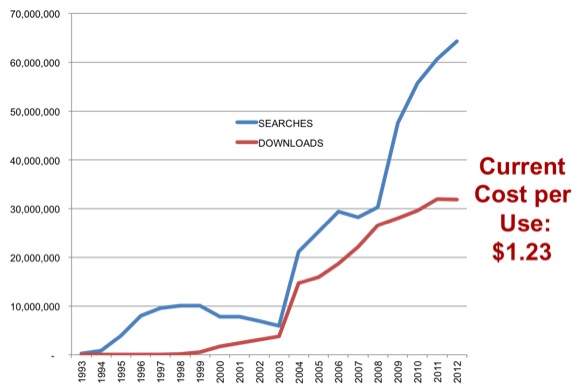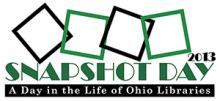Ed.—This post is the first in a series on OhioLINK topics in recognition of Ohio Library Snapshot Day (any day in November). During November 2013, libraries across Ohio are encouraged to pick a day to collect photographs, stories, information, and comments to show what takes place in the library on a typical day. For others in this series, follow the snapshot tag.
Now that I’ve been working at OhioLINK for a full year, I have a much better grasp of the true impact that OhioLINK can provide for students, staff and faculty members of Ohio colleges and universities. I have some facts and figures to share that back up my belief that OhioLINK provides our users with unrivaled value, but one of the very best parts about my job is running into OhioLINK users on a regular basis as I go about my daily routine.
Columbus is of course a huge college town, but it has many residents who graduated from colleges and universities all over Ohio. I’ll be buying a coffee, or renting a car, or walking the dog, and the person with whom I’m chatting will ask what I do for a living. Often their response when they find out that I work for OhioLINK is humbling and heartwarming. I’ve had current and former students tell me that they love OhioLINK because it gives them access to materials they never normally would be able to read, that they borrowed books through OhioLINK to write their honors thesis ten years ago, or that their spouses are graduate students and extremely enthusiastic OhioLINK users.
OhioLINK has a twenty-year history of successful shared services in the state of Ohio. The OhioLINK consortium now encompasses 91 public and independent colleges and universities, including community/technical colleges, the Cleveland Clinic and other research affiliates, and the State Library of Ohio. The shared resources available to the 600,000 students, faculty, researchers and staff at OhioLINK institutions include tens of millions of digitally published articles from top journals, tens of thousands of ebooks and dissertations, hundreds of databases and fifty million physical items that are lent and borrowed from OhioLINK member institutions, from both campus libraries and the five high-density regional depositories for physical library materials.
While OhioLINK receives operating funds from the state, as well as capital appropriations for digital content acquisition and other purposes, the power of OhioLINK comes from member participation. Member libraries acquire and share the books, audiovisual materials, government documents, etc., which are delivered to students, faculty and researchers around the state. In 2012, OhioLINK circulated 600,000 items to library users at member institutions at a cost of about $0.67 per item. That’s 600,000 books or other materials that a borrowing institution didn’t have to buy on behalf of its users.
OhioLINK also saves money for individual students and faculty. As an anonymous University o f Cincinnati student wrote on a chalkboard in the library, “I don’t have to pay for my books… so [OhioLINK] is as important as my paycheck.”
f Cincinnati student wrote on a chalkboard in the library, “I don’t have to pay for my books… so [OhioLINK] is as important as my paycheck.”
As comprehensive and heavily used as the print collections available through OhioLINK are, that activity is dwarfed by the statewide use of digital resources. In 2012, there were more than 30,000,000 downloads and over 60,000,000 searches performed in OhioLINK’s digital databases, e-books and e-journals. These materials from the top publishers in academia and research are also made available to all OhioLINK users. This pooled funding for expensive research and teaching material delivers another extraordinary value for Ohio students and faculty.
Collectively, OhioLINK member institutions buy $38 million dollars worth of digital content annually. Only 17 percent of that content is funded from central OhioLINK; 83 percent comes from the member institutions themselves. This shared-service model delivers a distributed print and digital library, available to all OhioLINK institutions, that rivals the library holdings of the elite academic institutions in the world.
While it’s a bit of an apples to oranges comparison, the Association of Research Libraries (ARL)1 reported that in 2012, Harvard spent approximately $45 million on all library materials, followed by Yale University ($36.9 million), University of Toronto ($27.9 million), Columbia University ($27.2 million), University of Michigan ($24.2 million) and Princeton University ($23.6 million). In the same year, OhioLINK and members spent approximately $33 million just on the shared digital content purchase, which is concentrated in the STEMM disciplines. OhioLINK’s shared service model makes this content available to a student at a two-year vocational program, an undergraduate at a small college, a faculty member at a public university or a biomedical researcher at a university medical center.
Not only does OhioLINK excel at competitive procurement and cost avoidance, preventing costly duplication at campus libraries, but this shared-service and cost-effective purchasing model allows more funds to be spent at the individual campuses on specialty library content tailored to their curricula and research agendas, expanding even more the total content available to their institutional users. This increases Ohio institutions’ competitive advantage in recruiting, retaining and supporting students and faculty.
OhioLINK is a member of the Ohio Technology Consortium, OH-TECH for short, and relies on sophisticated discovery and delivery systems to deliver both print and digital materials. But the fundamental business of OhioLINK and its diverse membership is creating cost-effective access to one of the largest academic library collections available.
OhioLINK – we’ve been putting the “I” in IT for more than two decades for the benefit of Ohio’s students, faculty and researchers. Aggregate statistics and facts and figures do tell the story of OhioLINK’s value; but an equally compelling story is the impact of OhioLINK on individual users. It’s an enormous perk of my job to receive all that gratitude and appreciation from OhioLINK’s enthusiastic fan base.



